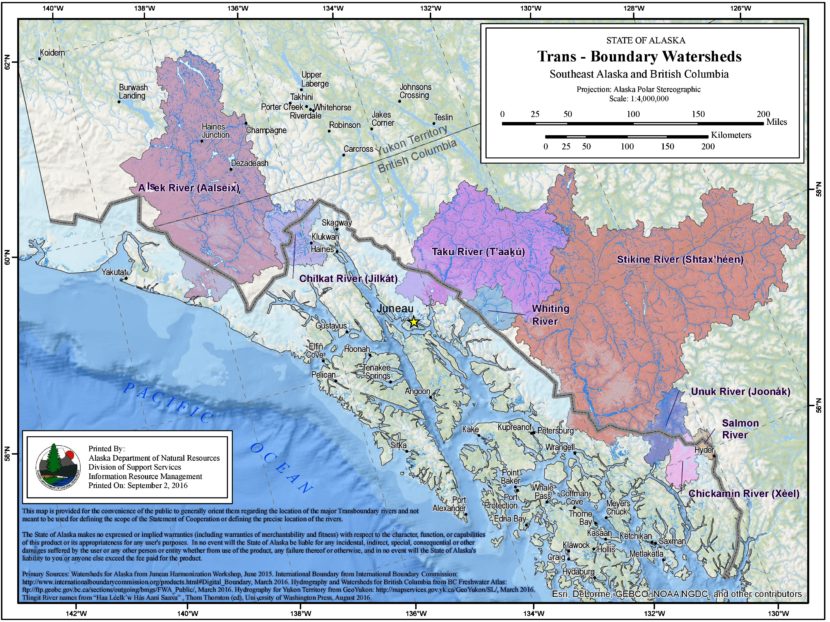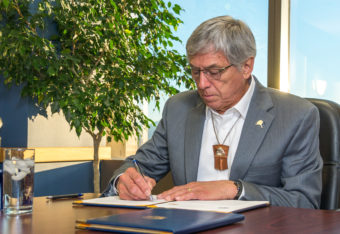
Alaska leaders want Secretary of State Rex Tillerson to push Canadian officials to better protect Southeast fisheries from British Columbia mine projects.
The governor, lieutenant governor and Congressional delegation made the ask in a joint letter sent Nov. 13 to the U.S. State Department.
Lt. Gov. Byron Mallott said officials want environmental protections discussed at an upcoming meeting of the department and its Canadian counterpart.
“We focused on asking them to have the B.C. mining projects, the transboundary treaty and the implementation of it as it relates to transboundary rivers in Alaska be included on their agenda,” he said.
State officials made similar requests to John Kerry, the previous secretary of state. But his department sent the issue back to Alaska, since it already was consulting with British Columbia.
Since then, tribal, environmental and fisheries groups have demanded stronger action to protect watersheds where Alaska salmon spawn and grow.
Chris Zimmer works for Rivers Without Borders, an environmental group that has warned of the dangers of transboundary mining for more than a decade.
“This is what’s been needed all along, is this concerted approach from our members of Congress and the state to the U.S. federal government,” Zimmer said. “And then hopefully what that will result in is a concerted approach to B.C. and Canada both, to deal with some current issues we have with transboundary mining.”
Two mines and more than a half-dozen exploration projects are active not far from the Alaska border.
Another long-closed mine is leaking acidic water.
The U.S. State Department’s Bureau of Western Hemisphere Affairs said the agency is aware of the concerns expressed in the letter.
“This is an issue we have raised with our Canadian counterparts at a number of levels with both provincial and federal governments, and we will continue to engage with them on it,” a spokesperson wrote in an email.
British Columbia officials said they’ve improved permitting and regulation of mines and mining projects with Alaska and other downstream interests in mind.
Mine owners and developers have said their projects don’t pose serious threats to Alaska.
The letter asks for specific steps beyond what’s already been done to be taken to protect Alaska waters.

Mallott said one important effort would standardize monitoring downstream from the mines and projects.
“Right now, water quality and other environmental data is gathered as the result of specific permits for specific projects,” Mallott said. “And we believe that that kind of monitoring should be undertaken on a consistent, over-time basis by our governments.”
The state signed a memorandum of understanding with British Columbia about a year ago.
But the provincial government has changed leadership, as have both federal governments.
Mallott said his administration continues working with provincial officials. He and other officials met with their British Columbia counterparts this month.
But he said the State Department needs to become a strong partner in those efforts.
The group Salmon Beyond Borders has recently criticized the state for acting too slowly. But spokeswoman Heather Hardcastle said the letter is a step in the right direction.
“They need to know that they’re not stepping on the toes of the state or the delegation, but instead (are) carrying out, really, united asks,” Hardcastle said.
The letter to Tillerson was signed by Mallott, Gov. Bill Walker, Sens. Lisa Murkowski and Dan Sullivan, and Rep. Don Young.
It said the state department should:
- Encourage B.C. officials to develop public outreach tools to better explain their processes for considering the cumulative impacts of proposed mining projects on transboundary waters during the environmental assessment process.
- Determine whether an International Joint Commission reference is a suitable venue to evaluate whether mines operating in the transboundary region between B.C. and Alaska are implementing best management practices in the treatment of wastewaters and management of potential-acid-generating mine tailings and waste rock.
- Establish a formal consultation process with U.S. state agencies, other federal agencies, tribes and Alaska Native Claims Settlement Act corporations during the environmental assessment process, similar to the consultation process afforded to a cooperating agency under the National Environmental Policy Act in the U.S.
- Support and work toward robust funding and other needed resources for developing a reliable database of water quality and related data for transboundary waters that can be used to track cumulative impacts, trends and significant episodic changes associated with operating and historic mines in the transboundary region.
- Establish an interagency task force led by the Department of State and including the Department of Interior, the Environmental Protection Agency and other agencies as necessary, to work in collaboration with the State of Alaska, and develop recommendations and direct funding to ensure protection of transboundary rivers.
Editor’s note: This report has been updated with comments from the U.S. State Department.
